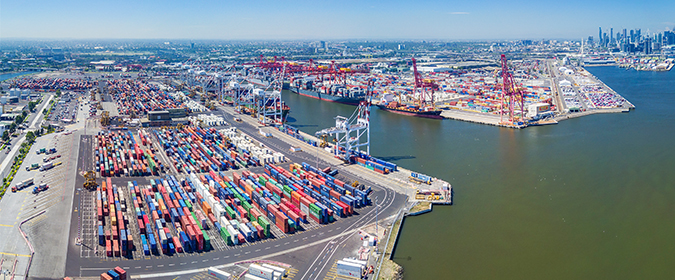The volume of world trade has grown 80-fold since 1950, yet world GDP has only grown 10-fold, which has meant the need for expanded intermodal infrastructure.
Eight million containers were shipped into U.S. ports in 1980, a figure that has exploded to nearly 45 million today, said Walter Kemmsies, managing director, economist and chief strategist at JLL’s U.S. Ports, Airports and Global Infrastructure Group. He moderated a panel on “Ports and Intermodal Development: Critical Links in the Supply Chain,” at CRE.Converge 2017 in Chicago.
Larger ships have been built to accommodate the demand for trade, however U.S. roadway infrastructure has not kept pace, which means that freight rail is increasingly the more effective option for moving cargo inland, Kemmsies said. The growth of e-commerce has resulted in the need to reorganize real estate to span national distribution centers, regional warehouses and last mile fulfillment facilities. “There is a whole rethink that is necessary if you’re going to move to an omnichannel distribution system,” he said.
The Port of Los Angeles, the nation’s largest with 7,500 acres and 43 miles of waterway, impacts one in nine jobs in southern California and sends cargo or passengers to every congressional district in the country, said panelist Gene Seroka, the port’s executive director.
The port works with the world’s largest ships and can handle two of them concurrently, with the ability to move goods to 11 different trains and a wide swath of warehouse space nearby, Seroka said. “We are the confluence of all these activities in supply chain,” he said. “The economic activity can’t be understated.”
The Georgia Ports Authority, which manages five deep water ports including the nation’s fourth-largest in Savannah, doesn’t handle ships as large as Los Angeles but has grown the fastest of any of the country’s top 10 ports, at 5.1 percent annually over the past decade, said Clifford Pyron, chief commercial officer.
Located in a city of just 225,000 people, the port boasts the single largest container terminal in the Western Hemisphere, at 1,200 acres, class 1 railroads within its facility and a location just six miles from I-95, Pyron said. Savannah has seen more than 50 million feet of warehouse space open nearby, much of it used by retailers who quickly move their goods into intermodal distribution. “It was just plain dumb luck with the geography,” he said, given the relatively large amount of open space compared to ports in denser areas.
Once goods flow into ports, the next step is often to get them out onto the railway. BNSF Railway, which serves 28 states in the western two-thirds of the country and operates over 32,500 miles, is served by more than 50 ports and more than 25 intermodal facilities, said Darrell Coffey, director of economic development and strategic programs.
“My goal in life is to work with the developer and real estate community to create new locations to build new facilities adjacent to our railroad,” he said. The intermodal business “is over half the volume we move. It’s extremely important to us.”
 This post is brought to you by JLL, the social media and conference blog sponsor of NAIOP’s CRE.Converge 2017. Learn more about JLL at www.us.jll.com or www.jll.ca.
This post is brought to you by JLL, the social media and conference blog sponsor of NAIOP’s CRE.Converge 2017. Learn more about JLL at www.us.jll.com or www.jll.ca.














